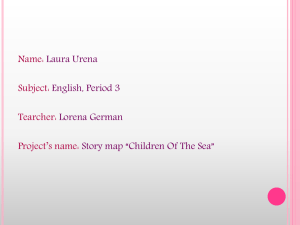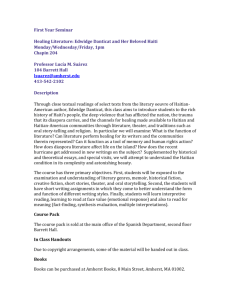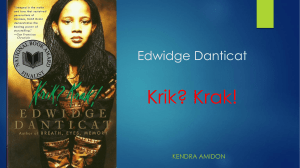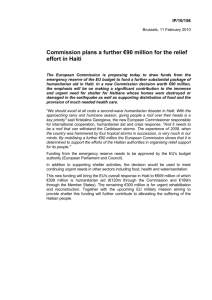Mortenson Center Distinguished Lecture
advertisement
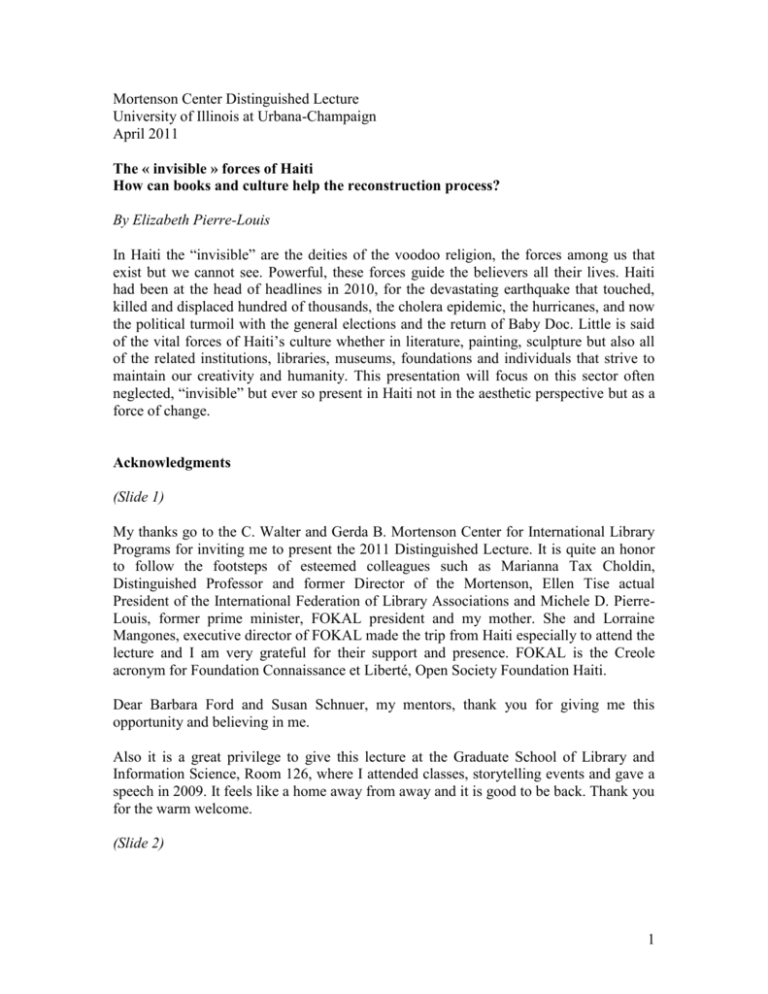
Mortenson Center Distinguished Lecture University of Illinois at Urbana-Champaign April 2011 The « invisible » forces of Haiti How can books and culture help the reconstruction process? By Elizabeth Pierre-Louis In Haiti the “invisible” are the deities of the voodoo religion, the forces among us that exist but we cannot see. Powerful, these forces guide the believers all their lives. Haiti had been at the head of headlines in 2010, for the devastating earthquake that touched, killed and displaced hundred of thousands, the cholera epidemic, the hurricanes, and now the political turmoil with the general elections and the return of Baby Doc. Little is said of the vital forces of Haiti’s culture whether in literature, painting, sculpture but also all of the related institutions, libraries, museums, foundations and individuals that strive to maintain our creativity and humanity. This presentation will focus on this sector often neglected, “invisible” but ever so present in Haiti not in the aesthetic perspective but as a force of change. Acknowledgments (Slide 1) My thanks go to the C. Walter and Gerda B. Mortenson Center for International Library Programs for inviting me to present the 2011 Distinguished Lecture. It is quite an honor to follow the footsteps of esteemed colleagues such as Marianna Tax Choldin, Distinguished Professor and former Director of the Mortenson, Ellen Tise actual President of the International Federation of Library Associations and Michele D. PierreLouis, former prime minister, FOKAL president and my mother. She and Lorraine Mangones, executive director of FOKAL made the trip from Haiti especially to attend the lecture and I am very grateful for their support and presence. FOKAL is the Creole acronym for Foundation Connaissance et Liberté, Open Society Foundation Haiti. Dear Barbara Ford and Susan Schnuer, my mentors, thank you for giving me this opportunity and believing in me. Also it is a great privilege to give this lecture at the Graduate School of Library and Information Science, Room 126, where I attended classes, storytelling events and gave a speech in 2009. It feels like a home away from away and it is good to be back. Thank you for the warm welcome. (Slide 2) 1 My lecture will be a journey full of expectations, questions and discovery. Some sites will be filled with beauty and awe; others will question our humanity; raise our consciousness or provoke ire. Common feelings when living in Haiti some would say. We will go back and forth in time, linking books and culture to crucial or trivial events of Haiti’s history. Let us set forth on our travel. Our first stop will have a title, a milestone for us to crossover. Reading Dangerously Professor Betsy Hearne, in “A Narrative Compass: Stories that Guide Women's Lives”, asked several women, scholars from different sectors, to testify about stories that guided their lives, that were the pivotal moment they could go back to and justify life choices, were an awakening to other worlds or an awareness of the change within. These are : The stories that have inspired them “and helped them learn wisdom”—stories that are so internalized and essential they serve as a “narrative compass. (Slide 3) For Edwidge Danticat, the narrative compass is an event related by the press, books, novels and family memories, the execution of Marcel Numa and Louis Drouin on November 12, 1964 in Port-au-Prince, Haiti. Numa and Drouin were part of 13 young Haitians who called themselves “Young Haiti” Jeune Haiti and who for three months in early 1964 fought Duvalier’s henchmen in the western tip of the country. All of them died in combat, except for these two who were captured and brought back to Port-auPrince to be executed, in front of a huge crowd. That day businesses were shut down and delegations of school children in uniforms were asked to attend this macabre event. A quote from her latest book of essays: Create dangerously: the immigrant artist at work: All artists, writers among them, have several stories – one might call them creation myths- that haunt and obsess them. This is one of mine . . .Like many a creation myth, aside from its heartrending clash of life and death, homeland and exile, the execution of Marcel Numa and Louis Drouin involves a disobeyed directive from a higher authority and a brutal punishment as a result. (Slide 4) Reading Edwidge Danticat’s essay resonates closely; Numa and Drouin are from my mother’s family hometown Jeremie and are names I used to hear at the dinner table regularly. The thirteen of Jeune Haiti were the sons, brothers, and husbands of the neighbors, of the cousins, of the friends of my family. (Slide 5) 2 In 2005 a FOKAL supported library in Jeremie chose the name Numa-Drouin a rightful homage to the disappeared ones. During the opening ceremony it was disheartening to realize that very few among the youth there heard of those names or of the heroic feats of Jeune Haiti. Little work had been done to preserve the memory. The Numa-Drouin library was the first step. This library is thriving now, the second one of the network to be computerized and offering a diversity of programs and books. A name, a library it seems so simple so innocuous, but in the ’60s in Haiti a library was not simple or innocent. “‘La jenes pa inosan’ Youth is not innocent,” says Manno Chalmay one of Haiti’s renowned militant singers. The Youth Library started in the early 60’s, specifically from 1961 to 1963. It was situated in the religious school of St Martial. (Slide 6) This school trained generations of Haitian men and is also well known for its historical library that still exist, Bibliothèque Haitienne des Pères du Saint Esprit housing the most important collection about the 18th century as well as the oldest book of the French colony of St Domingue. But the library I am talking about is a room where priests and professors would bring books that were shared but also discussed by young people who were enthused and eager to learn, to hear about everything that was happening in the world surrounding them. Volunteers took care of the collection. (Slide 7) A monthly magazine called Rond-Point was written by students and professors and sold to the public for 1.5 gourdes (3 cents). Sixteen issues were actually published and one bound collection is at the Library of Princeton University saved by the French professor Leon Francois Hoffman. He acquired it after all the protagonists were either dead, in prison or in exile at a small bookstore in Port-au-Prince where the owner kept all the “dangerous books” under her counter to be sold to foreigners or trusted locals. RondPoint is quite an extraordinary collection of articles about youth preoccupations: study choices, sports, but also philosophy and political doctrines. Professors abroad would send interviews with foreign scholars. Books would come from all over, shared and then sold in order to purchase others. The curiosity of the youth was insatiable; girls and boys would find a meeting place, a discussion ground where debate was encouraged. The conferences were also very appreciated. The library was a place of freedom, where ideas and ideals could be shared. One of the Youth library’s instigators, Jean-Claude Bajeux, who lost six members of his family to the Duvalier Regime, recalled that they were guided by their innocence and that the passion and stimulation that was created blinded the notion of prudence. The Duvalier regime was not very lenient and the Youth library would be quickly disbanded. At first, it was said that since the room of this library was the closest to the National Palace, Francois Duvalier complained that the lights and noise coming from that part of the building prevented his sleep. Then the repression hit hard. Quote from Danticat: 3 (slide 8) There were many recurrences of this story throughout the country, book and theater clubs secretly cherishing some potentially subversive piece of literature, families burying if not burning their entire libraries, books that might seem innocent but could easily betray them. Novels with wrong titles. Treatises with the right titles and intentions. Strings of words that, uttered, written, or read, could cause a person’s death . . . How do writers and readers find each other under such dangerous circumstances? Reading, like writing under these conditions is disobedience to a directive in which the reader, our Eve, already knows the possible consequences of eating that apple but takes a bold bite anyway. How does that reader find the courage to take this bite, open that book? After an arrest, an execution? Of course he or she may find it in the power of the hushed chorus of other readers, but she can also find it in the writers courage in having stepped forward, in having written or rewritten, in the first place. Create dangerously for people who read dangerously. This is what I’ve always thought it meant to be a writer.” Edwidge Danticat, Create dangerously: the immigrant artist at work The library, an invisible force opening minds, helping others to share, partake in a country more and more stifling where exchanges are carefully monitored. These windows of hope would not last long, but they exist and show the resistance of the Haitian spirit. In 1969 a law was passed that declared crime against the security of the state all display of communism, including possession of books, magazines, brochures. This crime was to be judged by a military court and punished by death and confiscation of all possessions. The executive settled these matters unbeknownst by the judicial system. In 1971, Jean-Claude Duvalier (Baby Doc), succeeded his father Francois at the age of nineteen. Times were changing and pressure from the outside world, especially the Carter administration seemed to announce a new era. Taking Baby Doc’s word about a so-called liberalization process that was to attract foreign investment and foster economic development, independent media set forth to create a short-lived but unprecedented free press movement in the country. Michele D. Pierre-Louis, “Reading the minds of democracy”, 8th Mortenson Distinguished Lecture, 1997 In 1979 a short decree signed by three ministers officialized the censorship of plays and movies in order to “protect families against pornography”. The reaction was immediate, more than one hundred and fifty artists, writers and intellectuals signed a letter to the government. The final sentence of this letter went as follows: 4 In this country tortured by hunger and poverty, we defend, as creators and demiurges, the right to bring freely to all a piece of the dream of hope. Letter to the Petit Samedi soir, May 1979 At the time, Franketienne’s play Peletent was for the last nine months creating a sensation in the country. Pelentet (“head trap”) is the Creole adaptation of the Emigrant by the Polish writer Slasmowit Mrozek. This tragedy portrays two Haitians exiled in New York, a factory worker and an intellectual sharing a room and their nostalgic, humorous and dramatic exchanges about their home country. Even though this drama was more existentialist then political the regime felt threatened. Also the use of the Creole language made it more popular. As were the radio programs from Radio Haiti Inter, radio Cacique and so on. In November 1980, a cruel repression would put a stop to all independent media and artistic activities. Those who were lucky to be sent in exile continued the resistance from abroad. The Diaspora, constantly growing with the stream of ousted professionals as well as boat people, would become another center of resistance and creativity. It also explains the Haitian literary paradox; the poorest country in the Western Hemisphere, with the highest number of illiterate people produces the most published books, more than the whole French speaking Africa. Furthermore, these books are acclaimed by the international critique. Edwidge Danticat (McArthur Fellowship), Dany Laferriere (Prix Medicis), Yannick Lahens, Guy Regis Jr, Marvin Victor, to name a few, are getting more and more world recognition. This travel stop of our journey gave light to a tragic time in Haiti, there is much more to say about this time and the role of books and culture, the examples selected illustrate the vital force of change and resistance. Nevertheless it is an important preoccupation to go back to this period of time. Since the return of Jean-Claude Duvalier on January 16 2011, there has been a strong inclination to rewrite history, to diminish the systematic repression of the Duvalier regime. It is our responsibility to keep alive the feats of our predecessors, and to support the activities to maintain the memory. This also is part of the reconstruction process. The reconstruction process (Slide 9) On January 12, 2010, a 7.0 earthquake hit Haiti. It lasted 35 seconds and changed our landscapes, our institutions our relationships and our mindsets. Eighty percent of the schools were destroyed; most public institutions were shutdown, limiting services such as the distribution of clean water, electricity, garbage disposal. Hundred of thousand of dead and injured, as well as displaced persons living in camps till today. More than a year later, a sense of normalcy has somewhat returned. Schools and universities have reopened in temporary lodgings. Stores, banks, airports are functioning 5 in the dysfunctional ways we are getting accustomed to. Using basic hygiene precautions, we are learning to live with cholera. Traffic is dense contouring destroyed buildings and piles of rubble. In front all this human suffering and loss, we could have felt helpless. And we did for a while. Then it dawned that we could do what we do best: continue the work. As soon as possible work resumed, step-by-step. Inventory (Slide 10) The library sector prior to the earthquake was quite limited. Even though the National library was established in 1940, showing the government’s concern in literary preservation and despite the existence of unique private collections, the public library was not a priority. A few statistics from the National Library: - Less then 30 cities out of 137 have libraries - Very little respect for standards : outdated or no catalogs, little classification scheme - Less then 5000 square meters of equipment when the minimum should be 50 000 - Less then 20 qualified professionals - No help for the local level (city council) to help libraries - Dispersion of the aid and no coordinated efforts - There are 16 municipal libraries under supervision of the National Library, 10 CLAC (supervised by the Direction Nationale du Livre) 6 Alliances Francaises (French cooperation) and 30 community libraries supported by Foundation Connaissance et Liberté (FOKAL). (Slide 11) In 1997, the Foundation Connaissance et Liberté (FOKAL) launched a library program supporting community libraries located in marginalized neighborhoods or in the countryside. Created in 1995, FOKAL is a national foundation, part of the Open Society Foundations financed by George Soros to help societies in transition. The Mortenson Center was instrumental in devising the strategy and implementing a training program that is still successful. Three teams of trainers attended three to six months sessions at the Mortenson. (Slide 12) The library program does not create libraries but supports local initiatives that are recognized by their communities and have a leadership position. (Slide 13) 6 In 1999 with the help of the French cooperation a network of 10 Centers for reading and cultural activities (CLAC in French) were inaugurated in the northern peninsula in Haiti. In 2005 a governmental decree created la Direction Nationale du Livre (National Office for Books), a new entity in charge of the promotion of public reading and books. The National Library had been in charge till then of this sector as well as the traditional role of conservation. Though created and in charge of the CLAC as well as cultural activities the DNL has a limited budget and staff that has hindered its activities. After the eathquake, the losses were important: (Slide 14) - The National Library had major repairs mostly of its materials. Four municipal libraries have to be reconstructed - 2 CLACs were destroyed as well as the DNL offices - The French Institute decided to close its Mediatheque, one of Haiti’s biggest library. The Alliance Francaise of Jacmel was damaged but the collection saved. (Slide 15) - Twelve of the thirty community libraries were damaged. Gathering forces (Slide 16) In 2004, after the departure of President Aristide, who incidentally is also back in the country, the cultural sector decided to come together and discuss about issues concerning them. The task was huge and it was the first time that so many sectors came together: literature, architecture, visual arts, theater etc. For about a year sixty organizations, associations as well as independent individuals, assessed, testified and wrote a presentation of their specific sectors assets, deficits and objectives. All this information was compiled in a brochure and presented to authorities as well as financial and grant giving institutions. The cultural sector, despite numerous economical, professional and organizational weaknesses, is nevertheless our best asset. Its main function is to regenerate the collective spirit and help the collective to develop a specific vision. Initiative pour la dynamisation du secteur culturel haitien, Cahier de charges, 2005 The effects of this work were not immediate but one indirect consequence has been, for example, the creation in 2010 by the European Union of a specific fund ARCADES devoted to the cultural sector. Within FOKAL, work restarted a month after the earthquake. For three weeks about 600 people camped in the parking lot. They evacuated peacefully and only a few members of the staff stayed a couple more weeks. Luckily no member of the staff was injured but the post traumatic stress was starting to take its toll. In order to help, group therapy sessions, 7 espace de paroles, space for speech were organized, and monitored by two trained psychologists. The space for speech were experimented before the earthquake, when implementing a major project of FOKAL: the Martissant Park Project. (Slide 17) The park is at the center of an ambitious project for this underprivileged neighborhood of Port- au-Prince, severely shaken by gang violence in recent years. The spaces of speech were a secure place, where members of different neighborhood associations could come and discuss about their worries, their hopes and fears. (Slide 18) These therapy sessions were organized also for the waste management program, financed by the European Union that was launched right after the earthquake. From these specific sessions it was possible to stem the needs of the population. A year later, this program had created family and neighborhood clusters in charge of waste collection, helped small enterprise use plastic waste for artistic purposes, intervene in schools but most importantly sign an agreement with city in order to collect waste regularly. One other big project will be the construction of the Katherine Dunham Cultural Center. In the library sector, the post earthquake gave a unique opportunity to put clannish disagreements aside and come together with a common presentation of our losses. This made the demands stronger and more articulate. Professionals were invited by Bibliotheque sans frontieres (Libraries without borders); the association of French librarians, American Library Association, the Association of Caribbean University Research and Institution Libraries, the International Federation of Library Associations to name a few. Fundraising efforts are still underway for projects ranging from Haitian interns in foreign libraries, to reconstruction of destroyed buildings. We also want to acknowledge the immediate reaction of the international library world right after the earthquake, the emails and messages of hope and solidarity were most appreciated. Strengthening capacities (Slide 19) Training was always one of the objectives of the library program. With less then 20 qualified professionals in the whole country, it was crucial to devise a training module that was adapted to the unique specifications of the Haitian community libraries. These small, heterogeneous were vibrant and dynamic but the staff lacked the basic understanding of library management. (Slide 20) 8 After the earthquake, training became even more crucial and we started to think outside the box. Since Port-au-Prince was out of the question, we devised training session outside of the capital city. Though the work was intense, the staff felt on holiday and got an opportunity to visit for the first time other regions of the country. The distance learning program is also a great endeavor in the making. This will facilitate training for professionals who cannot always come to the capital for several weeks in a row. Spreading the word (Slide 21) Communication has always been a weak link in Haiti. Maybe remembrances of times when it was better not to attract attention make communication a lesser priority. Since the earthquake, one important mission has been to keep the world informed of FOKAL projects but also about activities from other sectors in the arts. Nouvel FOKAL, a weekly newsletter, is one step in that direction. In Paris, members of the Association Monique Calixte and theater friends started a small volunteer initiative, “Lectures d’avenir” or “Readings for the future”. Every two weeks, actors read aloud piece of Haitian literature, essays, poetry but also Haitian recipes. The audience is small, but it keeps the image alive: a positive, brighter picture of the country. Creating and Preserving Is it necessary to recall that despite the constant devalorization of our country in the international press, our culture, by the diversity of its expression, is the still the symbol of the indisputed creative power of our people. (Slide 22) One acclaimed painter gave an interview two months after the quake, after creating a series of drawings depicting the images she saw. The black and white sometimes pencil thin lines depicted nightmarish scenes. The interviewer put a microphone in front of her and asked what she thought of Haitian Art. The painter drew a blank. Haitian Art was all over us, exposed in the street, scattered and damaged by the explosion of houses that were no longer their keeper. Artists were singing the lost ones, depicting, documenting. For all there was a before and after. (Slide 23) The Theater Festival Quatre Chemins (Crossroads) initiated in 2003 by a collective of 9 Haitian artists, is now a longterm partnership between FOKAL, the French Institute of Haiti, The Belgian Association La Charge du Rhinocéros and the French Community of Belgium. The idea is to rally each year during the last two weeks of September the wealth of artistic energies in Port-au-Prince around a theater event aimed at nurturing emerging young talents and civic spirits. Quatre Chemins is a festive and intense moment of reflection and debate on Haitian life, and of exchanges with theater professionals from other countries to develop quality and establish a space of free expression between the artists and the public in Haiti. In 2010, we decided to create a new version “Under construction”. Less theater meant that the plays had to be held elsewhere. Using lighter forms such as theater taxi where a comedian as well as driver takes the spectator to a unique tour of the city; this edition relayed on hands-on theater training in the streets of Port-au-Prince. The experience was interrupted due to the elections and their violent aftermath but generated an enormous enthusiasm. (Slide 24) Krik krak Festival initiated by Akoustik Production. This two-day storytelling event took place in the Southern city of Les Cayes. About 2,000 people attended the main recital the first night on the Place d’armes des Cayes. It was a challenge to offer a free cultural event in the middle of a heated electoral campaign. Poetry of spicy houses (Slide 25) In October 2009, the Gingerbread Houses of Haiti were included on the 2010 World Monuments Watch, to raise international awareness about this unique architectural heritage. Many of these once elegant, turn-of-the-century structures, detailed with fretted wood and intricate latticework, had fallen into disrepair. While political instability and economic strife had precluded substantive preservation efforts in recent decades, the Haitian Leadership and Education Program (HELP) brought the Gingerbread Houses to the attention of the World Monuments Fund (WMF), in the hopes of generating support for the revitalization of these important buildings and communities. Less than three months later, the devastating earthquake of January 12, 2010, all but shattered the Haitian people and the places they hold dear . . . Though many of the Gingerbread Houses suffered significant damage, their traditional construction proved seismically resistant and very few collapsed. Thus, the Haitian government prioritized these neighborhoods and their iconic architecture for international conservation assistance. Fondation Connaissance et Liberté (FOKAL), in partnership with HELP, then spearheaded a proposal for broad revitalization of the Gingerbread neighborhoods. Preserving Haiti’s Gingerbread House, World Monuments Fund report. Our travel in the present has ended, let us concluded by a return to the past. To the decisive moment in our history where slaves rebelled against the colonial order and for 10 the first time established themselves in 1804 as masters of their fate. Not taking for granted the abstract ideals of the 1789 French Revolution, until finally the Republic of Haiti was creating ending for good the French colony of St-Domingue. (Slide 26) How did the invisible forces of books and ideals touch this large majority of enslaved blacks? Jean Fouchard, in les Marrons du Syllabaire has a theory: How can we associate the degrading servitude to the most precious symbol of joy or nobility of freedom? But, as amazing as it seems, we find in the colonial hell of St-Domingue, slaves who knew how to read and write as well as liberated blacks and colored who had acquired the benefits of instruction. The slaves who knew how to read and write can be classified in two groups : the Islamized Blacks who, already in Africa, benefited in large part from a civilization who had glorious episodes ; and those, from different origins, who in St-Domingue, by a miracle of perseverance and will to elevate themselves, were able to outsmart the incredible difficulties that kept them in ignorance. To these and those, can be added the freed slave, this important number of blacks and mulattos who, long before the wars of independence, formed a team of intellectual preparation. Nevertheless, global instruction is not encouraged till now in Haiti and that can explain the lack of development from there on. But this is another presentation. My last quote: I could maybe live without writing. I do not think I could live without reading. Reading, I discovered, is prior to writing, but no society can exist without reading. Even in societies writing the chronic of their daily lives, reading is prior to writing; the one who wants to write must be able to recognize and decipher the social system of signs before being able to inscribe them on a page. Alberto Manguel, Une histoire de la lecture. Manguel adds that in literate societies reading is at the beginning of the social contract. (Slide 27) Our travels end here. How can books and culture help the reconstruction process? Perhaps by depicting another image or by giving diverse sources of income for a new development paradigm but perhaps also by developing the human spirit and lifting the barriers of our humanity through imagination and creativity. Showing that we are not mere bodies, exposed and pitiful, hungry and dirty but that the power of our mind, the genius of our inspiration can push the limits farther. 11 Sources Edwidge Danticat, Create dangerously, the immigrant artist at work, Princeton University Press, 2010, 189p. Bernard Diederich, “Le prix du sang” Tome II – Jean-Claude Duvalier: 1971-1986, l’Héritier, 2011, Port-au-Prince, 466p. Betsy Hearne, Roberta Seelinger Trites, in “A Narrative Compass: Stories that Guide Women's Lives”, University of Illinois Press, 2009, 269p. Jean Fouchard, les marrons du syllabaire, ed. Deschamps, Port-au-Prince, 1988, 159p. Albert Manguel, Une histoire de la lecture, Actes Sud, Paris, 2000, 432p. Michele D. Pierre-Louis, Reading the minds of democracy, 8th Mortenson Distinguished lecture 1997, Urbana 16p. Rond-point n1. Nouvelle Serie juillet 1962, Culture nationale, Port-au-Prince, 1962, 31p. Initiative pour la dynamisation du secteur culturel haitien, Cahier de charges, Port-auPrince, 2005 Fokal’s blog www.fokalnews.blogspot.com Report on Gingerbread house’s by the World Monuments Fund mission in Haiti http://www.wmf.org/sites/default/files/wmf_publication/WMF%20Haiti%20Mission%20 Report.pdf 12

